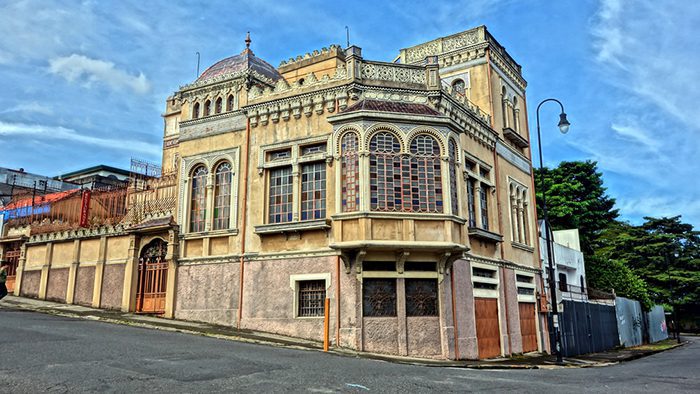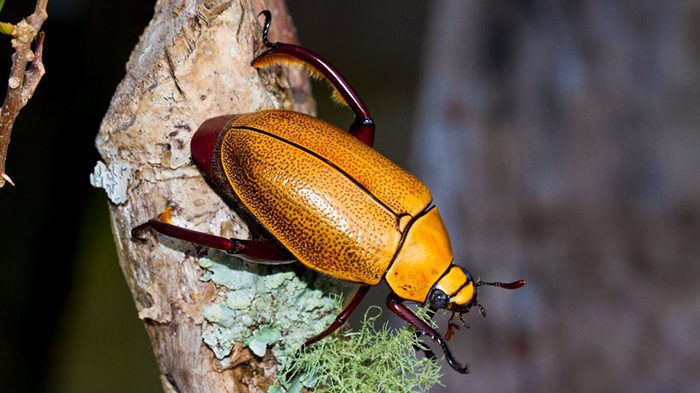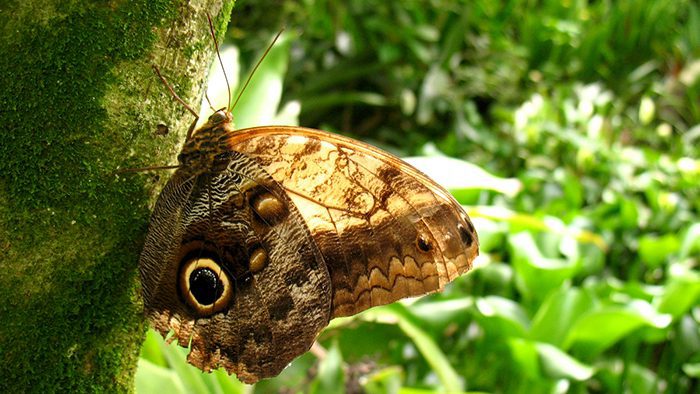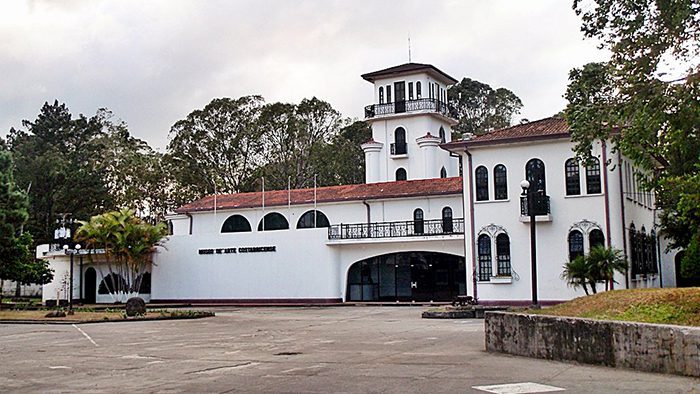Spanish for Saint Joseph, San José is the capital of Costa Rica and also happens to be the largest city in the country. San José was founded in 1739 by the Cabildo de León Spanish Council, making it the youngest capital city in Latin America. A third of Costa Rica’s population can be found living here and in the surrounding suburbs.

San José’s Avenida Central, or Central Avenue is the hub of all city activity. It runs from east to west along 20 city blocks in the heart of San José.
Avenida Central is as commercial as any European city street, with supermarkets, shopping centers, restaurants, businesses and fountains along its pedestrian walkways. For those who want to experience San José on foot, Avenida Central is the best place to meander about.

Barrio Amón is a lovely neighborhood in San José that features various restaurants, boutiques, art galleries, antique shops, cafés and hotels. Most of the area is pedestrian-only and a great way to see one of San José’s remaining colonial districts on foot.
Check out 5 Things to Do in Tamarindo
French immigrant Amón Fasileau Duplantier founded the neighborhood at the end of the 19th century after making a name for himself as a successful coffee baron. Since its construction, Barrio Amón has served as an upscale residential area for San José’s elite, which includes ex-presidents, actors and wealthy coffee moguls.

Nowadays tourists can marvel at the architecture in this pleasant historical section of the city, which is located near the flurry of downtown San José. It is considered to be one of the safest parts of the city and will lead you straight through to another historical neighborhood named Barrio Otoya.
Some splendid neo-Victorian examples in Barrio Amón have to be the Moorish-style Bishop’s Castle located on Avenue 11 and 3rd Street (Av 11, C 3) and the Alianza Francesa building located at C 5, Av 7.

Begin your downtown adventure at Plaza de la Cultura. Here you will find street dancers and entertainers, but you should not stick around too long as there is not much more to see here. The Tourism Information Office is close by and therein you will find the Pre-Columbian Gold Museum. Downtown San José is crowded and packed almost every day of the week and can be unsafe for tourists after dark, therefore I recommend your visit to the area before 4 p.m. so that your experience is as enjoyable as mine was.

Wrapping up at that time will also make you less vulnerable to pick pocketing and keep you away from the madness that is downtown’s rush hour. Many of San José’s attractions are located on or walking distance from downtown’s Avenida Central (National Theatre, National Cathedral, Congress building and National Museum).

The University of Costa Rica is one of the most prestigious in the country and is particularly renown for its entomology department. In 1962, the aforementioned sector of the university founded a center to educate the public about the importance and impact of those pesky little critters we call insects. It began with only 59 specimens housed in a single room. Since then, the exhibits have expanded into a vast complex, with over one million species of insects sorted by order.

With the noble goal of informing the public of insects in Costa Rica, the Insect Museum at the University of Costa Rica’s basement is a wonderful way to learn about the key roles these animals play in Costa Rican ecosystems. Bugs you will see include butterflies, beetles, dragonflies and many more. The museum is open Monday through Friday 1 to 4:45 p.m.

The Jade Museum is located on the ground floor of the National Insurance Building, which is the tallest building in Central America. The museum contains over 1,500 distinct pieces of Pre-Columbian Jade from the Americas, ranging from 500 B.C. to 800 A.D., making it the largest collection of its kind. Jade was a valuable commodity in pre-Columbian Central America

In recent years the Jade Museum has undergone much-needed lighting renovations, which have greatly improved the experience and allowed guests to better appreciate the luster of each piece. For the $8 entrance fee, visitors are given the opportunity to view extraordinary pieces of jewelry and other handcrafted jade items as well as a display showing how jade is carved.
Check out Things to See and Do in La Fortuna
Other collections include terra cotta pots and vases. The Jade Museum is open Monday through Friday 8:30 a.m. to 3:30 p.m. and Saturdays 9 a.m. to 1 p.m. It is closed on Sundays.

The Mercado Central, or Central Market was founded in 1880 and for the past century it has been supplying locals and tourists with clothes, medicine, flowers and everything in between. It is located on Avenida Central and contains some 200 stalls. Over 20,000 people come here daily to shop, socialize and grab a quick bite to eat at one of the sodas. The northern portion of the complex, known as Mercado Borbón, specializes in foods such as fresh fish, meats and fruits.

Although Central Market may not be for the faint of heart- carcasses and other such things are left out in the open, those who brave it will find themselves at the heart of this lively San José experience. Central Market is a great way to practice your Spanish skills while bargaining with the vendors. Something particular to look for is a pack of freshly roasted coffee beans. Take some home for you and your loved ones and brew yourself into bliss. The market is open 8 a.m. to 5 p.m. Monday through Saturday.

The Museo de Arte Costarricense, also known as the MAC, houses over 6,000 works of art. With invaluable paintings, sculptures, prints and photography, it is one of Costa Rica’s finest museums. The collections are housed in an elegant colonial-style building that once served at Costa Rica’s first international airport. Priceless art pieces from the 15th century to the modern day adorn the museum’s seven large galleries.

Exhibits showcase both local and international artists, plus there are several rotating exhibits throughout the year. There is also an outdoor sculpture garden to visit. The MAC is heralded as one of the country’s best cultural centers. The MAC is open Tuesday through Sunday 9 a.m. to 4 p.m. Admission is free.

For the past few centuries, gold has been one of Costa Rica’s defining features. It has drawn explorers, built towns, paid debts and shaped the nation. The Museum of Pre-Columbian Gold showcases gold’s significance in Pre-Columbian society.

Exhibits include gold figurines in the form of frogs or eagles, as ancient peoples revered these animals. Indigenous artifacts made of stone and ceramic dating back 12,000 years are also on display. Today the gold treasures are housed in well-lit, bi-lingual exhibition cases. Admission to the museum is $6, with students getting a 50% discount. Also included with your ticket is entrance to an art gallery and Museo de Numismática. The latter is home to rare coins and bills from across the world, some of them worth over a million dollars! Some of the artifacts found at the Museum of Pre-Columbian Gold date back to 500 A.D. Guided tours are available. The museum is closed on Mondays.

The aptly named Parque Central, or Central Park is the best place to begin your tour of San José. It is about the size of one city block and at its center is a massive fountain from 1868, casting shadows across the property. There is a constant buzz created by the local kids, who use the place like a rec center. Games, ranging from tag to mini golf, can be found taking place here daily.

Northeast of Central Park is Parque Morazán; a three-city block sized area that features a Japanese garden, statues, a dome-shaped music pavilion at its center and fountains. Although Central Park is the more famous of the two, Parque Morazán offers more interesting monuments to visit.

Within walking distance of the concrete jungle that is downtown San José, lies the Spirogyra Butterfly Garden – an environmental and socio-economic project aimed at protecting these small delicate creatures. Committed to preserving a habitat for their 25 species of butterflies, Spirogyra is one of the last small patches of forest remaining in San José. Right across from the El Pueblo shopping center, it’s one of the best places to just lounge in the shade, enjoy a cool drink and watch butterflies flit about.

A major goal of the owners is to promote awareness of the dangers many species of the butterfly face due to human expansion. Short of venturing out into the jungle, a trip to Spirogyra Butterfly Garden is by and far the best way to watch these magnificent creatures in their natural habitat. Licensed U.S. butterfly conservationists and zoos order their cocooned caterpillars from Spirogyra Butterfly Garden so that when metamorphosis is complete, more baby butterflies are born into North America. This butterfly haven is open daily from 8 a.m. to 4 p.m. Admission is $7.

The highest bungee jump in the Americas since 1991, this is not for chickens. All others can rest assured though, in over 30,000 jumps, there has never been a single accident. Jumpers are secured in three places: once on each ankle and around the waist.
Check out Top 10 Things to See and Do in Tortuguero, Costa Rica
The rig is anchored under the bridge in two places to ensure there is always a second as back up. The anchors can each hold 30,000 pounds. I went on three jumps myself and it was an amazing adrenaline rush. I had never gone bungee jumping before and this was the perfect initiation.

It is exciting, but slightly expensive at $75 for the first jump and $30 for the second, but a one-of-a-kind experience all around. If you cannot bring yourself to dive off the platform Tropical Bungee also guides rock climbing excursions, giant pendulum rides, rapelling on fixed ropes along ravines, canyon walls, or waterfalls, zip lining and a bungee trampoline. The best part of going bungee jumping with Tropical Bungee? The Bungee Bus ride is free to and from your hotel. Reservations are highly recommended.

Just 15 miles southeast of San José and nestled against the base of the Irazú Volcano, the town of Cartago is the oldest Spanish settlement in Costa Rica and was once the capital of the country. In 1565, King Philip II of Spain granted this agricultural city a coat of arms and in 1914, the Spanish Parliament bestowed upon the town the title of muy noble y muy leal, which translates to very noble and very loyal. Cartago remained the capital of Costa Rica until 1823, when Gregorio Jose Ramirez moved the capital to San José, whose citizens better supported the leader’s ideology. Cartago was damaged several times by earthquakes and once by a volcanic eruption that almost completely eradicated the city.

Cartago is also home to the gleaming white Basílica de Nuestra Señora de los Ángeles, Spanish for Our Lady of the Angels Basilica. The Basilica was built in 1639 and then partially rebuilt after the 1963 earthquake destroyed sections of the church. Because of the reconstruction, the Basilica has a unique mix of Byzantine and colonial architectural styles. The Basilica was originally built to commemorate the finding of a small statue of the Virgin Mary that features the black virgin holding an infant Jesus. La Negrita, as she called, can be found in a golden shell inside the church on the very rock where the statue was originally found. Pilgrims frequently visit the Basilica during the month of August, and often leave silver representations of body parts they wish to be healed in front of La Negrita.
Check out Top 10 Things to Do in Jaco
Some other places of interest around Cartago are the 27-acre Lankester Botanical Garden with an impressive orchid collection, the beautiful Orosi Valley with views of the Irazú Volcano and Ujarras Ruins, the picnic perfect Tapanti National Park and the Raventazon River- a white water rafting haven.

You can get to Cartago from San José by taking a 45-minute bus ride from San José from Calle 5, Avenidas 18/20 or from Calle 3 and Avenida 2. The buses come by every five minutes and run until 10 p.m. The round trip will cost you a whopping $2, making this day trip budget-friendly.

About an hour northwest of San José via Route 1 is the artisanal town of Sarchí, famous throughout Costa Rica’s for its exquisite hand crafted items. Sarchí is home to more than 200 family-owned stores and workshops that create wooden masks, jewelry, a wide variety of kitchen and tableware items and leather goods. Ambrosio Alfaro Godinez first settled the town in the mid 19th century and the name originates from the Aztec word for “the relaxed place.”

The most traditional handcrafted item in Sarchí is the carreta, an intricately painted ox cart that represents what was used in the region to haul coffee from mountain farms to Costa Rica’s seaside ports. The carts were first painted in the early 1900’s as a weatherproofing method for the wood. But over the years, the decorations have evolved into colorful and intricate designs. The carts are now used only for festival displays. The world’s largest ox cart can be found in Sarchí’s Parque Central, which is near the church. The ox cart, about 45 feet long and weighing in at around 2 tons, was built specifically to earn the town a place in the Guinness Book of World Records.

Examples of Sarchí’s heritage are visible throughout its streets. The main church, which was built in the 1950’s, features a central tower that resembles a wedding cake, a vaulted ceiling and an elaborate carving etched by local artists. Visitors looking to purchase crafts should stop by the Mercado de Artesanías, a large warehouse store that is operated by the local craftsmen cooperative.

Although not full of modern buildings and refined restaurants, there is a great deal of history and charm in Costa Rica’s capital. Tradition is the name of the game and the Ticos, as the locals are referred to, are friendly and in love with the traditions of their culture. Remember to be aware of your surroundings while in downtown. Don’t hang around there in the late afternoon, but definitely make it out to the area to get the full experience.
Check out The Best Beaches in Costa Rica
My Tropical Bungee experience was unforgettable! Who would have thought that near death experiences could be so addictive? In Sarchí I purchased a bunch of tiny handmade ox carts, which my friends and family found to be such a thoughtful gift. I recommend you pick some up for those back home as they are quite cheap and have become somewhat of the Costa Rican national symbol. I sincerely hope you choose to stay in the Alta because my experience there was nothing short of amazing. The staff is super friendly and the view is just what the doctor ordered. Overall, San José is a photographer’s dream come true with its unique mixture of old and new world.
Time zone: Because of its proximity to the equator, Costa Rica does not observe Daylight Savings Time. During U.S. Daylight Saving Time, Costa Rica’s time zone is equivalent to Mountain Standard Time. From November to March, Costa Rica’s time zone is equivalent to Central Standard Time.
Getting around: From the airport, take one of the red taxis into San José. They can be found just beyond the airport’s main exit. A taxi ride into the city will cost you about $15. San José has budget-friendly public transportation that includes buses and taxis. The buses operate daily from 5 a.m. to 11 p.m., but be aware there is no official bus schedule. If you are in doubt where a bus stop is, just ask someone. Taking a taxi is the other option. Only red taxis are official and come equipped with working meters. If you are scheduled for a tour or day trip outing, be sure to arrange transfers with whichever company or tour group you book.
The San José train system is a work in progress, but could be a good option to cut traveling time to places like Belen, Pavas, San Pedro and Curridabat and Heredia.
Currency: The national currency is the colon (CRC) and both dollars and Euros may be exchanged at banks.
Currency converter: XE
Best time to go: Dry season (late November through April).
Did you enjoy the article what to see and do in San Jose, Costa Rica? Leave us a comment below!
Counter
101 Countries • 1432 Cities
Abbie says:
This is great information. Thank you very much for sharing.